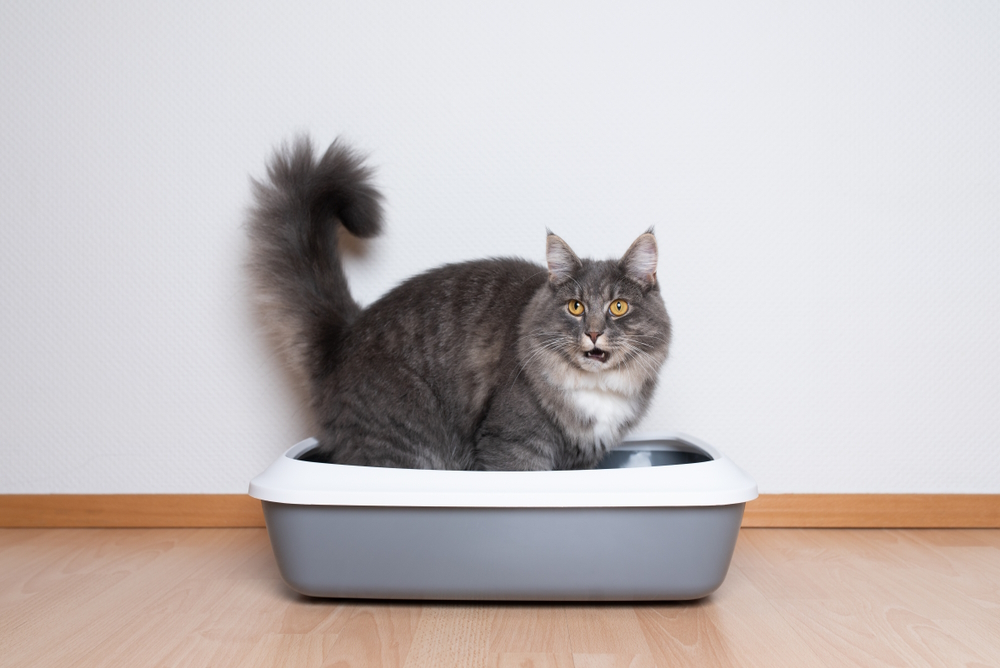In case your cat is straining to move feces, otherwise you’ve observed some blood of their poop, there are a number of potential causes this could possibly be taking place, certainly one of which is rectal polyps; small growths from the liner of the rectum that may trigger bleeding and discomfort.
Rectal polyps are often benign, hardly ever painful, and never very often recognized in cats. Nonetheless, it’s commonplace for homeowners to report blood on or of their cat’s feces, so it’s potential that rectal polyps could possibly be extra frequent than we notice.
Let’s study a bit extra about rectal polyps in cats so you understand what to be looking out for, and when you should see the vet.


What Are Rectal Polyps?
A polyp refers to a progress or outpocketing of tissue from the mucous membrane, on this case, of the rectum. They’re sometimes benign, however in uncommon circumstances, they could be cancerous. Rectal polyps usually are not generally reported in cats, and cancerous ones are even much less so.
Polyps are available in two varieties:
- Pedunculated – appears to be like like a small sac hooked up by a stalk
- Sessile – a raised, flat outpocketing
What Are The Indicators of Rectal Polyps in Cats?
Polyps bleed fairly simply, and the most typical signal of rectal polyps in cats will likely be recent blood on the feces, though they don’t often look like painful. If the polyps develop massive sufficient, they could trigger issue passing feces (tenesmus), or end in diarrhea attributable to irritation. Often, straining might trigger a polyp to prolapse by the anus, the place it will be seen as a moist, crimson, or bleeding lump.
How Are Rectal Polyps Identified?
The analysis of rectal polyps is often based mostly on bodily and visible examination. Your vet will use a finger to really feel for any abnormalities contained in the rectum, and will even use an endoscope to look at the liner of the colon.
If the polyp is eliminated, your vet may additionally suggest sending the tissue away to verify the analysis and guarantee there are not any indicators of malignancy (most cancers).

How Are Rectal Polyps in Cats Handled?
In lots of circumstances, polyps are simply monitored, as remedy will not be wanted.
Nonetheless, if the polyp(s) is rising in dimension, inflicting discomfort, or issue with passing feces, surgical removing could also be wanted. Probably the most troublesome side of eradicating rectal polyps is getting good entry and visualization; the removing itself is often easy, and restoration tends to be fairly fast and uneventful.
When Ought to My Cat See The Vet?
It’s not unusual for cats to expertise occasional bouts of gentle constipation and a small quantity of recent blood within the feces isn’t essentially a serious trigger for concern. Nonetheless, that doesn’t imply we ought to be ignoring these indicators. If you’re seeing any of the indicators under, it’s time to ebook your cat in for a check-up:
- No feces for greater than 48 hours
- Straining to move feces for greater than 24 hours
- Frequent constipation (greater than 2 or 3 instances a yr)
- Frequent blood in/on feces
- Great amount of blood in/on feces
- Intense licking of anus/genitals
- Swelling or lumps across the anus
- Bloated stomach
- Diminished urge for food
- Every other indicators of sickness/ache

What Can I Do For My Cat With Rectal Polyps?
In case your cat has been recognized with rectal polyps, crucial step you’ll be able to take to attenuate the dangers of them inflicting issues or prolapsing is feeding your cat the correct weight loss program. Being carnivores, cats don’t want fiber of their weight loss program from a dietary standpoint, but it surely does play an necessary function in producing wholesome stools in home cats.
Shaped, agency stools are at all times excellent, significantly in case your cat has rectal polyps. Poops which might be fairly tender or unfastened will get caught up on these polyps, placing your cat liable to additional irritation and an infection. Nonetheless, we have to keep away from overly massive poops, as this could trigger stretching and bleeding of polyps, in addition to the rectal wall and anus.
Search for a weight loss program that comprises round 5% fiber for lively cats, and shut to fifteen% for our extra sedentary felines.
Ensuring your cat has common checkups with the vet can be necessary in order that they’ll monitor the dimensions of the polyps.
What Different Circumstances Have Comparable Indicators To Rectal Polyps in Cats?
Being a comparatively unusual situation in cats, it is very important concentrate on another, extra frequent situations which will have comparable scientific indicators to rectal polyps. They embrace:
All of the above situations could cause tenesmus, blood within the feces, and irritation & irritation across the anus, and all the above situations require veterinary assist to unravel.


Ultimate Ideas
Rectal polyps usually are not quite common in cats and are hardly ever trigger for main concern. Nonetheless, they sometimes should be eliminated, and also can mimic a number of different situations. Whereas the occasional hint of blood within the feces isn’t an emergency, in case your cat is often having issue going to the bathroom, spending a variety of time licking ‘down there’, or if bloody poops have gotten a frequent incidence, don’t hesitate in reserving your cat in for a checkup with the vet.
Featured Picture Credit score: Nils Jacobi, Shutterstock
